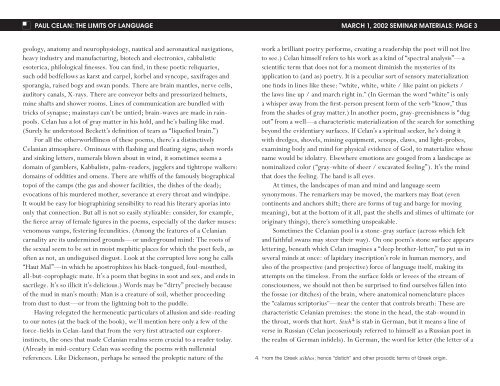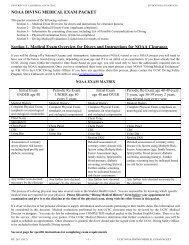You also want an ePaper? Increase the reach of your titles
YUMPU automatically turns print PDFs into web optimized ePapers that Google loves.
PAUL CELAN: THE LIMITS OF LANGUAGE MARCH 1, 2002 SEMINAR MATERIALS: PAGE 3<br />
geology, anatomy and neurophysiology, nautical and aeronautical navigations,<br />
heavy industry and manufacturing, biotech and electronics, cabbalistic<br />
esoterica, philological fi nesses. You can fi nd, in these poetic reliquaries,<br />
such odd bedfellows as karst and carpel, korbel and syncope, saxifrages and<br />
sporangia, raised bogs and swan ponds. There are brain mantles, nerve cells,<br />
auditory canals, X-rays. There are conveyor belts and pressurized helmets,<br />
mine shafts and shower rooms. Lines of communication are bundled with<br />
tricks of synapse; mainstays can’t be untied; brain-waves are made in rainpools.<br />
Celan has a lot of gray matter in his hold, and he’s bailing like mad.<br />
(Surely he understood Beckett’s defi nition of tears as “liquefi ed brain.”)<br />
<strong>For</strong> all the otherworldliness of these poems, there’s a distinctively<br />
Celanian atmosphere. Ominous with fl ashing and fl oating signs, ashen words<br />
and sinking letters, numerals blown about in wind, it sometimes seems a<br />
domain of gamblers, Kabbalists, palm-readers, jugglers and tightrope walkers:<br />
domains of oddities and omens. There are whiffs of the famously biographical<br />
topoi of the camps (the gas and shower facilities, the dishes of the dead);<br />
evocations of his murdered mother, severance at every throat and windpipe.<br />
It would be easy for biographizing sensibility to read his literary aporias into<br />
only that connection. But all is not so easily stylizable: consider, for example,<br />
the fi erce array of female fi gures in the poems, especially of the darker muses:<br />
venomous vamps, festering fecundities. (Among the features of a Celanian<br />
carnality are its undermined grounds—or underground mind: The roots of<br />
the sexual seem to be set in moist mephitic places for which the poet feels, as<br />
often as not, an undisguised disgust. Look at the corrupted love song he calls<br />
“Haut Mal”—in which he apostrophizes his black-tongued, foul-mouthed,<br />
all-but-coprophagic mate. It’s a poem that begins in soot and sex, and ends in<br />
sacrilege. It’s so illicit it’s delicious.) Words may be “dirty” precisely because<br />
of the mud in man’s mouth: Man is a creature of soil, whether proceeding<br />
from dust to dust—or from the lightning bolt to the puddle.<br />
Having relegated the hermeneutic particulars of allusion and side-reading<br />
to our notes (at the back of the book), we’ll mention here only a few of the<br />
force-fi elds in Celan-land that from the very fi rst attracted our explorerinstincts,<br />
the ones that made Celanian realms seem crucial to a reader today.<br />
(Already in mid-century Celan was seeding the poems with millennial<br />
references. Like Dickenson, perhaps he sensed the proleptic nature of the<br />
work a brilliant poetry performs, creating a readership the poet will not live<br />
to see.) Celan himself refers to his work as a kind of “spectral analysis”—a<br />
scientifi c term that does not for a moment diminish the mysteries of its<br />
application to (and as) poetry. It is a peculiar sort of sensory materialization<br />
one fi nds in lines like these: “white, white, white / like paint on pickets /<br />
the laws line up / and march right in.” (In German the word “white” is only<br />
a whisper away from the fi rst-person present form of the verb “know,” thus<br />
from the shades of gray matter.) In another poem, gray-greenishness is “dug<br />
out” from a well—a characteristic materialization of the search for something<br />
beyond the evidentiary surfaces. If Celan’s a spiritual seeker, he’s doing it<br />
with dredges, shovels, mining equipment, scoops, claws, and light-probes,<br />
examining body and mind for physical evidence of God, to materialize whose<br />
name would be idolatry. Elsewhere emotions are gouged from a landscape as<br />
nominalized color (“gray-white of sheer / excavated feeling”). It’s the mind<br />
that does the feeling. The hand is all eyes.<br />
At times, the landscapes of man and mind and language seem<br />
synonymous. The remarkers may be moved, the markers may fl oat (even<br />
continents and anchors shift; there are forms of tug and barge for moving<br />
meaning), but at the bottom of it all, past the shells and slimes of ultimate (or<br />
originary things), there’s something unspeakable.<br />
Sometimes the Celanian pool is a stone-gray surface (across which felt<br />
and faithful swans may steer their way). On one poem’s stone surface appears<br />
lettering, beneath which Celan imagines a “deep brother-letter,” to put us in<br />
several minds at once: of lapidary inscription’s role in human memory, and<br />
also of the prospective (and projective) force of language itself, making its<br />
attempts on the timeless. From the surface folds or levees of the stream of<br />
consciousness, we should not then be surprised to fi nd ourselves fallen into<br />
the fossae (or ditches) of the brain, where anatomical nomenclature places<br />
the “calamus scriptorius”—near the center that controls breath: These are<br />
characteristic Celanian premises: the stone in the head, the stab-wound in<br />
the throat, words that hurt. Stich 4 is stab in German, but it means a line of<br />
verse in Russian (Celan jocoseriously referred to himself as a Russian poet in<br />
the realm of German infi dels). In German, the word for letter (the letter of a<br />
4. From the Greek stikhos; hence “distich” and other prosodic terms of Greek origin.





